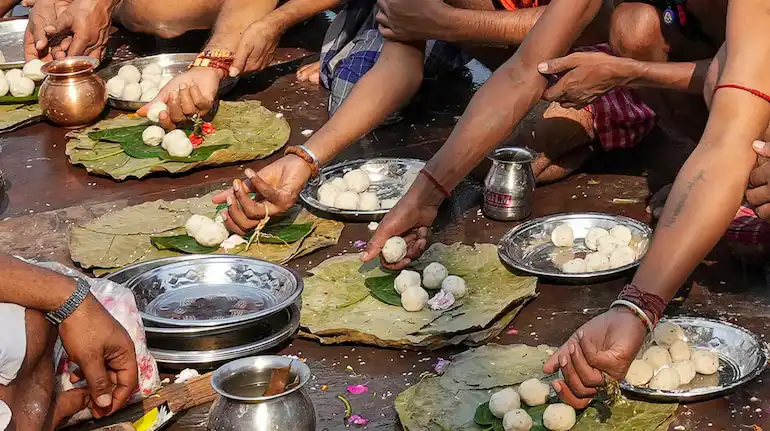Mahalaya in Guwahati is the heartbeat before Durga Puja—the day the city wakes up to the dhaak and the timeless Mahisasura Mardini chants. It marks the end of Pitru Paksha, the start of Devi Paksha, and sets the festive tone for pandal-hopping and celebration. In 2025, Mahalaya is more than a date; it is the spiritual call that makes every Guwahatian count the days to Puja.
What is Mahalaya in Durga Puja?
Mahalaya is the day that marks the end of Pitru Paksha (a fortnight dedicated to paying homage to ancestors) and the beginning of Devi Paksha (the fortnight dedicated to Goddess Durga). It falls on Mahalaya Amavasya, also called Mali Amavasya, when Hindus perform tarpan rituals to honor departed souls.

Culturally, Mahalaya is also remembered for the iconic radio broadcast of Mahisasura Mardini a devotional recitation by Birendra Krishna Bhadra, traditionally played at dawn. For Bengalis in Guwahati and across Assam, this sound officially signals: “Durga Puja is coming.”
Why Mahalaya is Important and Why We Celebrate It
Mahalaya carries layered meanings, spiritual, cultural, and emotional—that make it indispensable for Bengalis and Assamese alike.
1. Spiritual Importance
Mahalaya marks the end of Pitru Paksha, a period of offering respect to ancestors through rituals like tarpan. By performing these rites, people seek blessings from forefathers and prepare themselves spiritually to welcome Maa Durga.
2. Why Celebrate Mahalaya
It is celebrated because it ushers in Devi Paksha, the fortnight when Goddess Durga is believed to begin her journey from Kailash to her maternal home on Earth. The day transforms the city’s mood; solemnity gives way to festivity. From Mahalaya morning onward, Guwahati starts vibrating with the anticipation of Puja.
3. Link with Durga Puja
Mahalaya is not the start of Durga Puja rituals but its symbolic countdown. Idol-makers perform Chokkhu Daan (painting the Goddess’s eyes), and pandal committees accelerate their work. Mahalaya’s completion marks the official declaration: “Durga Puja is near.” Without Mahalaya, Puja feels incomplete it’s the bridge between ancestor remembrance and Goddess worship.
4. The Song of Birendra Krishna Bhadra
Perhaps nothing defines Mahalaya more than the radio broadcast of “Mahisasura Mardini”, narrated by Birendra Krishna Bhadra. First aired in 1931, this combination of Sanskrit verses, devotional songs, and orchestral music has become inseparable from the Mahalaya dawn. In Guwahati, families wake before sunrise, tune in to All India Radio, and let the voice of Bhadra set the spiritual rhythm for the day. Even today, despite modern versions, his rendition remains timeless, goosebump-inducing, and the true call of Mahalaya in Guwahati.
Mahalaya 2025 Date and Time in Guwahati
- This year, Mahalaya date: Sunday, September 21, 2025.
- It coincides with Amavasya Tithi, marking the perfect day for tarpan.
| Event | Date | Tithi Begins | Tithi Ends | Notes |
| Mahalaya Amavasya 2025 | Sept 21, 2025 (Sunday) | 9:29 PM, Sept 20 | 10:43 PM, Sept 21 | Ancestor rituals (tarpan), Chandipath, festive invocation |
In Guwahati, families often gather near the Brahmaputra ghats on Mahalaya morning for rituals. Priests perform tarpan, offering water and prayers to forefathers. The act of offering during mahalaya time is considered highly auspicious, believed to grant peace to departed souls.
How Many Days Left for Mahalaya?
As of September 21, 2025, Mahalaya is today so 0 days are left. It marks the symbolic start of Devi Paksha, and from this morning, the countdown for Durga Puja in Guwahati officially begins.
Rituals and Traditions of Mahalaya in Guwahati
Mahalaya in Guwahati is a mix of devotion, culture, and tradition:
1. Tarpan on Mahalaya Amavasya
At dawn, men gather at riverbanks, especially the Brahmaputra ghats to perform tarpan. Offerings of water, sesame seeds, and prayers are made to ancestors. In Guwahati, Nabagraha ghat and Uzan Bazar ghat are among the busiest places for this ritual. This practice symbolizes gratitude and ensures blessings from forefathers.
2. Chandipath and Mahisasura Mardini Broadcast
Even before sunrise, Guwahati households tune in to Mahisasura Mardini. The conch sounds, slokas, and dhak beats played over the radio create nostalgia, connecting generations. Families listen together, some while preparing offerings for tarpan.
3. Chokkhu Daan (Eyes of the Idol)
In traditional practice, artisans paint the Goddess’s eyes on idols only after Mahalaya. In Guwahati’s Kumartuli-inspired idol-making hubs, Mahalaya morning is when Maa’s gaze is drawn, bringing the clay idols to life.
4. Start of Puja Preparations
Markets in Guwahati bustle on Mahalaya day, florists sell marigolds, vendors prepare puja essentials, and committees finalize pandal decorations. Streets like Fancy Bazar and Beltola see an early-morning rush.
Cultural Significance of Mahalaya in Guwahati
Mahalaya is not just a religious ritual; it is a cultural reset. For Guwahatians:
- It marks the start of the festive season from Durga Puja to Diwali.
- Families use it to reconnect with roots, calling relatives, sending greetings, and remembering elders.
- The Assamese diaspora abroad often live-streams the Mahisasura Mardini broadcast or watch modern adaptations online, feeling an emotional connection to home.
- Local TV and radio channels air Mahalaya specials, while community groups host Chandipath recitations.
Mahalaya vs Shasthi – What’s the Difference?
Mahalaya is the invocation day, marking Devi’s descent and the start of Devi Paksha. Shasthi, on the other hand, is when Durga Puja actually begins with rituals like Bodhan and Kalparambha. Mahalaya is the spiritual call; Shasthi is the official start.
Conclusion
Mahalaya in Guwahati 2025 is more than a date on the calendar—it is the city’s cultural awakening. From the solemnity of tarpan at the Brahmaputra to the joyous beats of Mahisasura Mardini echoing through homes, Mahalaya connects Guwahatians with ancestors, faith, and community.
It sets the stage for Durga Puja: artisans bring Maa Durga’s idols to life, pandal committees race to finish their themes, and families begin planning pandal-hopping routes. For the Assamese diaspora, it’s a nostalgic bridge to home, reminding them that no matter where they are, the Goddess descends the same day everywhere.
As Devi Paksha begins, Mahalaya reminds Guwahati that Durga Puja is not just about celebration—it is about continuity, memory, and devotion. The city stands ready, hearts open, waiting for Maa Durga’s arrival in all her glory.
Frequently Asked Questions
When is Mahalaya in 2025?
Mahalaya falls on Sunday, September 21, 2025, coinciding with Amavasya Tithi.
What is the significance of Mahalaya Amavasya?
Mahalaya Amavasya is when Hindus perform tarpan rituals to honor ancestors. It closes Pitru Paksha and opens Devi Paksha, symbolizing the Goddess’s descent to Earth.
How is Mahalaya celebrated in Guwahati?
In Guwahati, Mahalaya is marked by dawn tarpan at Brahmaputra ghats, listening to Mahisasura Mardini, and artisans performing Chokkhu Daan on idols.
What time does Mahalaya start?
In 2025, Mahalaya Amavasya Tithi begins at 9:29 PM on Sept 20 and ends at 10:43 PM on Sept 21, making Sept 21 the day of Mahalaya.
